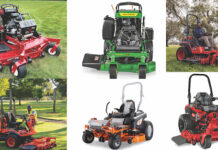The global robotic lawn mower market is expected to grow by nearly 22% over the next six years, reaching $1,400.62 million by 2025, according to a recent study conducted by Grand View Research, Inc. Specifically, a compound annual growth rate (CAGR) of 21.9% from 2019 to 2025 is predicted based on several driving factors over the forecast period. These include: the introduction of energy-efficient gardening equipment; rising popularity of green roofs; rising adoption of gardening as a hobby; and rising disposable incomes.
Key suggestions from the report include:
- Based on battery type, the 20V to 30V segment accounted for the largest robotic lawn mower market share in 2018. It is expected to remain the dominant segment over the forecast period as well.
- The residential segment is expected to emerge as the largest segment of the market by the end of the forecast period. This can be attributed to the rapid expansion of the residential construction sector, especially across developing economies.
- An upsurge in the demand for landscaping services and the popularity of gardening as a hobby in several countries is projected to spur the demand for a variety of robotic lawn mowers over the forecast period.
- Europe holds a significant share of the robotic lawn mower market (around 30% in 2018) and is likely to remain the dominant market over the forecast period.
- The vendor landscape of the robotic lawn mower market is highly consolidated and characterized by a high level of competition with the presence of players such as Husqvarna Group, Deere & Company, American Honda Motor Co., Inc., and Robert Bosch GmbH.
The rapid expansion of the residential construction sector in several countries is expected to spur the demand for landscaping services, which, in turn, is expected to propel the sales of robotic lawn mowers over the forecast period. Additionally, the popularity of well-kept yards and backyard beautification activities is on a rise, predominantly in developed economies, and people are spending increased funds on making their lawns aesthetically appealing. Furthermore, factors such as strong GDP growth, along with a notable rise in disposable incomes across developing economies, are positively affecting market growth by allowing increased investment into properties with sizable lawn areas. These factors are likely to drive market growth over the next few years.
The presence of intelligent sensory controls in robotic lawn mowers is also expected to significantly impact the market demand in the near future. Furthermore, key players are engaged in integrating ledge sensors and additional features such as laser vision, smart navigation, lawn mapping, memory, and self-emptying in their products to enhance the performance and efficiency of these devices.

Competitiveness among manufacturers is anticipated to intensify as a number of companies are focusing on expanding their product portfolio by introducing advanced features or technologies in their existing products lines. For instance, Husqvarna Group announced that robotic mowers with Husqvarna Automower® Connect, will be able to use voice commands via Amazon Alexa and Google Home. With this, owners can use voice commands to start, stop, park, and get updates related to the working condition or the whereabouts of their lawn mowers.
However, the increasing popularity of artificial turf is expected to serve as a major threat to the global demand for robotic lawn mowers. The convenience and low-cost associated with artificial grass are driving its increased adoption across residential as well as commercial spaces, thereby hindering the market growth.
To access the entire 110-page report entitled “Robotic Lawn Mowers Market Size, Share, & Trends Analysis By Battery Type (Less than 20V, 20V to 30V), By End Use (Residential, Commercial), By Region, And Segment Forecasts, 2019 – 2025”, click here.











![[VIDEO] Dickies®: Discover Workwear That’s Anything But Uniform](https://turfmagazine.com/wp-content/uploads/2023/06/1647663814-4b1a2a7742790a9b1e97a3b963477850192e1d6a9dfba9b07214a77bae25d6e3-d-218x150.jpg)





























![[VIDEO] Dickies®: Discover Workwear That’s Anything But Uniform](https://turfmagazine.com/wp-content/uploads/2023/06/1647663814-4b1a2a7742790a9b1e97a3b963477850192e1d6a9dfba9b07214a77bae25d6e3-d-324x160.jpg)